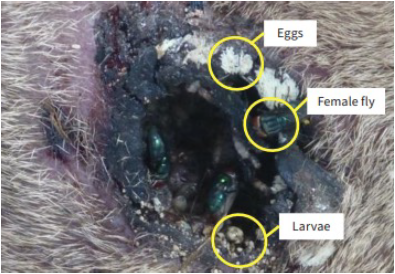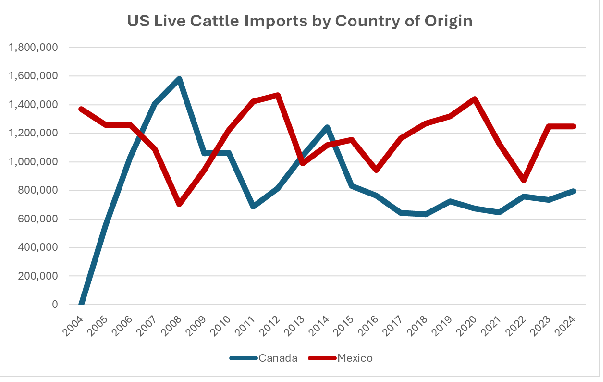New World Screwworm (NWS)
ENTFACT-519: New World Screwworm | Download PDF
Hannah Tiffin (Assistant Extension Professor, Medical/Veterinary Entomology, Department of Entomology), Jessie
Lay (Animal Health Extension Veterinarian), and Kenny Burdine (Extension Professor, Department of Agricultural Economics).
University of Kentucky College of Agriculture
 Fast Facts:
Fast Facts:
- NWS is a fly species with maggots that burrow deep into animal tissue and cause extensive tissue damage, leading to secondary infections and even death. This results in high economic costs due to animal loss and treatment, as well as pest containment and control efforts.
- The United States has been considered NWS-free since 1966, with a few notable outbreaks.
- The current outbreak is north of the Panama barrier zone, with outbreaks detected in Mexico.
- NWS has not been detected in the United States during the current outbreak.
- It is critical to understand and follow cattle-import regulations to prevent an outbreak of NWS in the United States, which would be devastating for U.S. cattle health, producers’ livelihoods, and consumers’ access to beef and other livestock products and byproducts.
WHAT IS IT AND WHY SHOULD
PRODUCERS CARE?
Background Information
New World screwworm, or NWS for short, can cause serious tissue destruction and lead to disease and death in livestock and other animals. The fly larvae, or maggots, “screw” their way into living animal tissue by tearing through and eating the host’s tissue with sharp mouth hooks. This causes extensive tissue damage and can lead to severe secondary infections as the maggots cause deep wounds, leading to sickness and potentially death in untreated animals. The NWS flies are often associated with cattle but can affect sheep, goats, horses, and other livestock and companion animals, as well as wildlife species including infrequent reports on birds, and in rare circumstances can affect humans.
An outbreak in Texas in 1976 infested nearly 1.5 million cattle and over 300,000 sheep and goats before the outbreak was contained. Adjusted for inflation, this could cost Texas producers alone an estimated $732 million in treatment, control, and livestock losses, and the Texas economy overall $1.8 billion. Since NWS eradication, most outbreaks in the United States have been limited to Texas and other southwestern states, with one notable exception affecting Key deer in the Florida Keys in 2016 and contained in 2017.
Today, these flies are found in several South American and Caribbean countries. However, they used to have a wider range that included Mexico and extended to the southern United States, including Kentucky. Fortunately, NWS was eradicated from the United States, and the United States was considered NWS-free in 1966. To reduce risk of reintroduction of these pests from Mexico and Central America, the United States partnered with Mexico and Central American countries to continue eradication programs and push this pest southward, with a permanent barrier zone established in Panama in 2006. In collaboration with Panamanian authorities, this barrier zone releases sterilized male flies that mate with females and prevent the females from producing new flies, reducing the overall NWS fly burden and limiting northward expansion of this pest from the barrier zone.
Why Is This a Problem Now?
For a variety of reasons, NWS was able to move northward from the Panama barrier zone and made its way through Central America into Mexico, risking re-introduction to the United States from the movement of infested animals through the livestock trade (legal and illegal), travel, and border crossings of stray livestock, equids, and wildlife from affected regions.
There has always been a risk of re-introduction of NWS since the southern United States has the right environment for this pest given its historic range throughout the South. Live cattle trade and this pest’s resilience highlight the importance of vigilance and international and intergovernmental cooperation and collaboration. While there have been several outbreaks of NWS in the United States, all outbreaks were able to be contained through coordinated efforts by the USDA and other inter-agency and international partners.
NWS has been confirmed in cattle north of the Panama barrier zone, including in southern Mexico. There have not been confirmed reports in the United States but with NWS moving northward, it is imperative that producers continue to follow USDA regulations for live bison, cattle, and equine imports and stay vigilant for this pest, particularly in border states such as Texas. Sterile male NWS flies are being released in these outbreak locations to reduce the number of flies and to re-establish barrier zones in outbreak locations, with the goal of pushing NWS southward to the well-established Panama barrier zone.
How Does NWS Affect Animal Health?
While maggot (fly larvae) infestation is not uncommon, the New World screwworm causes much more harm than species that typically affect U.S. livestock. Most species of maggots found in the United States infest infected wounds and feed on necrotic (dead) tissue at the skin’s surface. Instead of staying at the tissues’ surface to feed, NWS maggots burrow deeper into wounds to feed on healthy tissue. This is extremely painful to affected animals and causes severe lesions and extensive tissue damage. The female flies can be attracted to even minor wounds, such as bites from other insects or ticks or the umbilical cord of a newborn calf. Female flies will also deposit eggs in mucous membrane openings such as the nose, eyes, ears, anus, and genitalia. As the maggots continue to feed on deeper tissues, the wounds enlarge and frequently develop secondary infections, which can lead to death of the animal.
If the outbreak spreads to the US, early detection will be essential to prevent potentially devastating losses. Producers should call their veterinarian if they notice maggots deep in wounds, a strong smell of decaying flesh, or wounds that grow rapidly in size and are infested with maggots in companion animals, livestock, or wildlife.

ECONOMIC IMPACT
Mexico-U.S. Cattle Trade
The ban on live-cattle imports from Mexico has also affected U.S. cattle markets. A significant number of cattle are imported from Mexico to enter the U.S. beef system each year. These tend to be lighter cattle that would be placed in a growing program, such as grazing or backgrounding, before entering a feedyard.
The first ban on live-cattle imports from Mexico occurred in late November of 2024 and decreased the total number of imports from Mexico for several weeks last year. For perspective on volume, 2024 live-cattle imports from Mexico would have likely represented 4-5% of U.S. feedlot placements for the year. Importantly, these imports represent a much larger share of feedlot inventories in the southern United States, including Kentucky.
The initial ban on live-cattle imports from Mexico was lifted in February of 2025. Cattle began to move north again, but at a reduced pace compared to most of 2024. Mexican cattle imports were down by 32% in March of 2025 compared to March of 2024 and were down more than 50% year-to-date. The latest ban was put in place on May 11 and remains in effect at the time of this writing.
What Impact Has The Ban Had on Cattle Markets?
The reduction in live-cattle imports further reduced an already tight feeder-cattle supply. Both bans resulted in price increases, with CME© feeder-cattle futures prices reaching record highs. In the short term, supplies will continue to tighten while the import ban is in place. Longer-term implications are less clear, as feedlot and packing capacity (especially in the South) are somewhat dependent on Mexican cattle imports. How long the ban lasts and the implications of continued reductions in feeder-cattle supply remain key questions going forward. However, keeping the United States NWS-free is critical for ensuring food security for U.S. consumers and economic stability and longevity for cattle and other livestock producers given the New World screwworm’s ability to infest a wide range of animals.

WHAT IS KENTUCKY DOING?
Federal, state, and local officials and specialists are monitoring the situation. An emergency response plan is in place if
detected in the United States, with a specific control plan in place if detected in Kentucky.
Kentuckians, What do You Need To Do?
Follow import/export regulations for all animals including livestock, equines, and domestic pets. Helpful links to USDA regulations are included below.
- Livestock imports from Mexico: https://www. aphis.usda.gov/live-animal-import/cattle-bison-germplasm/mexico
- Live animal imports, any country: https://www. aphis.usda.gov/live-animal-import
- Domestic dog import permit requirements: https://www.aphis.usda.gov/pet-travel/another-country-to-us-import/dogs
Stay aware of the situation and changes in import/ export regulations. Current NWS outbreak situation: https://www. aphis.usda.gov/livestock-poultry-disease/cattle/ ticks/screwworm/outbreak-central-america
Know the signs of NWS and where to report if you have a suspected case. Observable signs to report include:
- Smell of decaying flesh on your animals
- Wound(s) or openings (nostrils, genitalia) with maggots on your animal
- Animals with irritated behavior and/or head shaking
Report it! If you have a suspected case of NWS on one of your animals or wildlife in your area, contact an accredited veterinarian or one of the agencies below. KY Department of Agriculture, Office of the State Veterinarian Phone: (502) 573-0282
https://www.kyagr.com/statevet/
USDA-APHIS Veterinary Services In Kentucky, phone: (502) 848-2040
